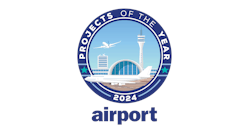Stand curbside at any major U.S. airport terminal and you likely will see a chaotic environment of taxis, transit buses, airport shuttles, private vehicles and ride app drivers picking up or dropping off passengers. This is an inefficient, unpleasant and often unsafe experience for travelers.
But thanks to the advent of Connected Automated Vehicle technology, airport owners have a new tool to address passenger terminal bottlenecks. And the best part is this technology, which operates on existing infrastructure while carrying a large number of passengers, is available now.
In a 2018 HNTB America THINKS survey, 69 percent of Americans said access to and from terminals and on-site parking needed improvement.
To help alleviate the problem, airport owners have built automated people movers and relocated parking lots, garages and consolidated rental car facilities off-site. APMs offer numerous mobility and environmental benefits, but are not right for every airport.
Depending on specific needs, CAVs can present a viable, efficient alternative.
Autonomous vehicles operate with an array of onboard sensors that detect and make independent decisions based on surroundings. Connecting AV and CAV to each other and the infrastructure make them able to handle special cases like weather and obtain higher speeds on dedicated guideways, as well as interacting with pedestrians and other vehicles when operating at lower speeds on regular roadways. Self-driving vehicles can pick up and drop off passengers at remote lots and locations or can shuttle passengers between terminals.
CAV technology is best suited for fixed-routes with defined coverage areas, making it a fit for airports because:
- Airports typically set their own rules and regulations, and adapt faster to new technologies
- Airports offer a controlled environment, where AVs can be separated from non- automated vehicles and pedestrians
- The technology has evolved to a level of sophistication sufficient for reliable use at airports
The decision to go with CAVs or APMs depends on the specific needs of each airport, including its budget, layout and comfort level with new technology.
APMs generally serve airports shuttling large numbers of passengers on a limited circular or linear route that never deviates. But an airport with a wider network of stops may see automated vehicles as a solution, since CAVs can go where needed.
Factors for owners to consider before deciding on an AV system include:
Capital cost. The price of a CAV system will vary based on the airport’s needs; however, the system likely will cost far less than an APM due to the lighter, more modular structures and lower vehicle and system costs. For example, a study for the Greenville-Spartanburg Airport District estimated a new half-mile light rail system would cost $258 million, while a CAV system would cost $86 million and be constructed in half the time. This is similar to other projects HNTB has evaluated where costs can be reduced to a fraction of the APM capital costs.
Flexibility. The APM is a dedicated, permanent fixture at the airport, while automated vehicle routes can be moved to accommodate construction or as terminal demands shift.
Infrastructure requirements. All initial and ongoing expenses associated with APMs, including maintenance facilities, rail and signal systems, fixed track and electrical power, are eliminated with automated vehicles. Stations, necessary with either mode, are simpler and more economical for AVs, as they only require a raised curb and a canopy, at minimum.
CAVs are fully autonomous when operated in dedicated lanes. Because of precision driving capabilities, AVs can navigate narrower lanes as a “virtual rail” compared to conventional vehicles, similar to APMs.
While a safety operator is needed off a dedicated guideway, as the technology matures and self-driving vehicles become mainstream, the vehicles will no longer need dedicated lanes and roadways built exclusively for them and could be designated for universal use.
Capacity. An APM can have a four-car train, with each car carrying up to 100 standing passengers. CAVs also can form trains to handle big crowds, with a typical shuttle having the ability to carry between 124 and 245 passengers while making more frequent stops.
Lifecycle costs. Both APMs and automated vehicles require upkeep, but a CAV system has fewer components to maintain. When automated vehicle technology requires updates, owners can upgrade the software in their fleet without replacing the vehicles themselves. Additionally, CAVs have no track infrastructure that requires extensive maintenance.
System conversion. Realizing automated vehicle technology is now implementable, airport owners may consider updating existing APMs or repurposing those systems to accommodate a more economical CAV. This depends, as every airport faces different needs, and automated vehicles may not make sense in some situations. But when developing curbside congestion solutions, it doesn’t currently make sense to consider CAV technology as a replacement, complementary or stand-alone system option unless a dedicated lane is provided.
Market penetration
Based on vehicle miles traveled trends, automated vehicles could represent 10 percent of the U.S. fleet as early as 2023. More conservative projections say 2030, with CAV sales reaching 33 million by 2040.
No U.S. airport has implemented an automated vehicle program yet, but Seattle-Tacoma International Airport and the Greenville-Spartanburg Airport District have added automated vehicles to their long-range master plans.
Airports outside the U.S. have been more receptive to the technology. Since 2011, London’s Heathrow Airport has operated a 21-vehicle rapid transit system. Mercedes recently demonstrated its larger autonomous bus on a 20-kilometer rapid transit route at Amsterdam Airport Schiphol. And in Paris, an AV pilot was deployed in April 2018 to connect Charles de Gaulle International Airport to the city.
AVs also have been deployed at airports in Amsterdam, Hong Kong and Frankfurt, Germany.
Ready to roll
As airport owners evaluate how to address congestion at their terminal curbsides, automated vehicles are another tool that can be considered now to reduce the number of vehicles picking up and dropping off passengers.
Tom Rossbach is the national aviation architecture leader for HNTB Corporation. He provides strategic direction for projects within the national aviation market and has nearly 35 years of terminal planning, design, and airport P3 development experience. He can be reached at [email protected].
Robert James holds a patent for connected automated vehicles and is recognized for being the first in the United States to propose using connected vehicles and connected infrastructure to automate vehicles to improve safety. He also is a New York City MTA Genius Transit Challenge winner. James was a founder of the Smart Road at Virginia Tech and was the first to design the Smart Road facility for testing automated vehicles and concepts. He can be reached at [email protected].






